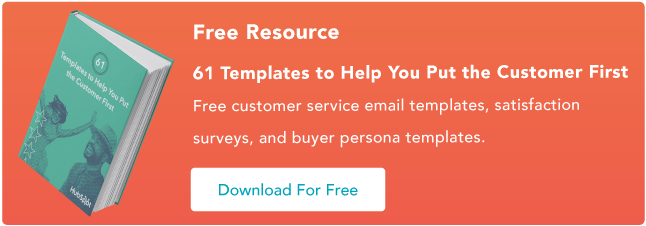In this post, we'll explore seven types of segmentation that can enhance your team's emotional intelligence. Read for more.
Segmentation Models to Enhance the Customer Journey
1. Demographic Segmentation
Demographic data is typically the starting point for discussions on segmentation. Basic demographic information is vital in the types of products and services a customer is interested in and what messaging will be the most relevant to them.
With demographic segmentation, you would typically segment customers based on the information you might find on a census form. Some examples of demographic data include:
- Sex
- Age
- Income level
- Generation
- Marital status
- Religion
- Education level
Among many other data points.
While individuals within a single demographic group can have sharply different interests, demographic information can help you broadly understand a customer's likely preferences concerning your brand.
For example, segmentation data can help reveal life insurance appeals most to customers 30 years or older. Married couples and parents may be more interested in the product as well.
That's reflected in the images Liberty Mutual chooses for their website.

Demographic data is some of the easiest for brands to obtain, thanks to census data, surveys, analytics data, and the information your customers supply themselves.
While demographic data is typically only the starting point, it gives you a better idea of a customer's lifestyle and interests, allowing you to communicate with them more effectively.
A 2022 survey found that 74% of consumers prioritized feeling valued and understood regarding brand loyalty.
The key to fostering brand loyalty is creating a personalized experience for the customer, which demographic segmentation facilitates.
Demographic segmentation is the first step in creating a personalized experience that delights customers.
2. Firmographic Segmentation
You can think of firmographic data as demographic data for businesses instead of people. For B2B businesses, firmographic segmentation is a valuable method for categorizing prospective and current business customers.
Firmographic segmentation can address various grouping factors for an organization. Some examples of firmographic data are:
- Size and number of employees
- Sales and revenue
- Ownership structure (public, private, government)
- Industry type
- Growth status (stable, downsizing, growing)
By segmenting B2B customers with firmographic data, you can better focus on the unique challenges each customer segment might face and how your company can better address these concerns.
For example, the challenges faced by a healthcare company will be quite different than those confronted by an engineering firm, even if your brand can serve both businesses.
LinkedIn holds a treasure trove of firmographic data for your segmentation strategy. In fact, 97% of B2B marketers use the platform when forming their marketing strategies.
We recommend heading there for firmographic segmentation data to help you create influential customer segments.
You may also consider surveys for achieving the most up-to-date firmographic segmentation data available. Some example questions you may ask on a firmographic survey include:
- What is your company's industry? (Select all that apply.)
- How many people are employed at your company? 1-49, 50-999, 1000-4999, 5000, or more.
- Which best describes the growth status of your organization? Growing, stable, downsizing, or other. (Please specify.)
- What was the (approximate) annual revenue of your company last year?
As with demographic segmentation, firmographic segmentation is a starting point. Accurate emotional intelligence requires you to dig deep to understand clients' needs.
By performing quality segmentation early, your team will be better equipped to speak their language and communicate effectively.
With firmographic segmentation, you'll better understand where your business customers are coming from and their needs.
71% of consumers expect personalized interactions throughout their customer journey, which also applies to B2B customers.
To deliver those personalized interactions, you need to start with firmographic segmentation.
3. Behavioral Segmentation
Behavioral segmentation is the process of grouping customers and leads into segments based on the actions they take concerning your company.
Behavioral data mostly comes from your owned platforms, like your website, emails, and social media. Some examples of data points you may consider in your behavioral segmentation strategy include:
- Date of last website visit
- Last visited website page
- Did they abandon their cart?
- How quickly did they navigate away from your page after visiting?
Almost any interaction metrics you can track from your website, applications, or emails, can be used in behavioral segmentation. Therefore, it is essential to form a behavioral segmentation strategy and decide which metrics you need to track.
Behavioral data offers direct insights into where someone might be in their relationship with your company. This information can help guide appropriate messaging to drive conversions, increase ROI, and predict customer behavior.
Using behavioral segmentation and on-site data, you can determine your most engaged customers and interact with them accordingly. You can perhaps offer them discounts for their loyalty or encourage repeat purchases.
As mentioned above, website actions provide insight into a customer's needs or the type of messaging that will most appeal to them. For example, makeup brand Sephora sends customers a 20% discount email after they spend over $200.

The most valuable information for behavioral segmentation comes from simply keeping track of customers' last interaction with your brand, which a good CRM can help you do.
Good information from your brand's owned platforms leads to improved emotional intelligence and positive, personalized customer interactions.
For example, a customer who just had a negative experience with one of your e-commerce products will likely respond poorly to an email encouraging them to buy a related item.
Instead, they are more likely to improve their perception of the brand if a customer service rep reaches out to resolve their complaint.
Behavioral segmentation helps guide you in making the right choice and sending the right messaging in response to your customer's actions.
You can use behavioral segmentation to send personalized product recommendations based on customers' past purchase behavior.
Today, customers are more concerned with receiving information that is relevant to them, as opposed to just being notified about the newest product launch.
Accordingly, customers are 2.6 times more likely to convert when presented with purchase-history-based recommendations.
According to Omnisend, sending three abandoned cart emails can increase order rates by 69%.
Using the information already available through owned channels ultimately allows you to segment your audience so each individual gets the right message at the right time.
4. Psychographic Segmentation
Psychographic segmentation helps brands divide their audience based on their personalities, attitudes, interests, hobbies, values, and lifestyles.
While such information can be harder to quantify than behavioral data, it can make all the difference in ensuring your message is genuinely on point with your target audience.
Psychographic segmentation enhances your emotional intelligence because it doesn't just tell you what to talk about or which messages you should send when. Instead, it directly informs you how to communicate with your customers.
When you understand a person's core values, you can appreciate their life priorities and pain points.
Sales teams and customer service reps can better sympathize with the customer's situation. They can then use language that helps customers feel their concerns are being heard and taken seriously.
The importance of understanding the psychographics of your target audience is evident when a domestic brand attempts to expand to other countries.
Companies need to adapt to cultural differences (which encompass values, lifestyles, attitudes, and more) when expanding to new foreign markets.
Failing to do so will result in unclear messaging and an experience that doesn't resonate with customers.
For example, in the 1970s, Avon needed to adjust its traditional door-to-door sales approach when expanding to Asian markets to cater to cultural differences and preferences.
In Japan, sales representatives would not knock on strangers' doors as they did in the United States because this was considered an unwelcome intrusion.
This cultural mismatch was just one of many reasons why the company struggled to make much of an impact in Japan.
Another example of psychographic segmentation data is consumers' attitudes toward environmental, social, and governmental (ESG) issues.
A study by McKinsey found that younger generations, in particular, will consider ESG factors when choosing brands to buy, with two-thirds of younger respondents indicating at least one ESG factor as important to them.
McKinsey's survey is an example of psychographic and demographic data coming together to inform what a group of people values and how you can market to that accordingly.
5. Geographic Segmentation
Geographic segmentation creates marketing segments based on where people live, work, or shop.
People living in a specific area will likely share similar values, needs, and cultural norms. Geographic segmentation allows you to target audiences in particular regions or countries with messaging that appeals to their needs and pain points.
Geographic segmentation considers factors like location, population, climate, and culture.

Location
This category can be as broad as continents and as narrow as specific neighborhoods within a city.
Companies will implement geographic segmentation to offer different products and services in different areas or to target ads to individuals based on their location data.
Population
The population density of an area can dictate your desired messaging or if you want to serve an area in the first place.
Some brands may only want to operate in cities with a high population. In contrast, others may choose to market in smaller, more rural areas, as their products typically resonate better with people living in those areas.
Have you ever seen a Bass Pro Shop in midtown Manhattan? Probably not. That's population segmentation at work.
Climate
People living in different climates have different needs. For example, if you sell winter coats, you may want to target individuals who live in cooler temperatures or are planning to travel somewhere cold.
Accordingly, if you build custom outdoor pools, you may not have luck finding customers in Finland.
Culture
Cultural differences account for everything from food and drink preferences to religious ideologies and more.
McDonald's is an example of a brand that takes advantage of geographic segmentation, offering customized menus catered to the culture of each country.
For instance, their Indian menu features no beef, considering the majority Hindu population. They also have a McSpicy Paneer that we'd like to try.
Geographic segmentation is more accessible to implement than other types of segmentation, considering the limited data points required.
However, in combination with other segmentation efforts, it can help optimize your marketing and increase profits.
According to a recent study among U.S. marketers, 9 in 10 marketers believed that incorporating geographic/location data into their marketing efforts led to an increase in revenue.
Another 83% shared that geographic data helped them deliver relevant content to consumers — so don't forget to incorporate geographic segmentation into your marketing and personalization efforts.
6. Technographic Segmentation
Technographic segmentation seeks to create customer groups based on the usage of or relationship to technology.
For individual consumers, you might look to track the type of mobile phone they use, their operating system, preferred browser, and openness to new types of technology like VR and AR.
Technographic segmentation is more commonly used by B2B marketers. In combination with firmographic data, technographic segmentation can provide a clear picture of a company's tech needs and how you may be able to help.
In the B2B context, technographic segmentation is based on a company's tech stack, or all the technology that powers their business. That includes both software and hardware.
There are three main methods of collecting technographic data.
Surveys
Straight from the horse's mouth. Surveys are the most direct method of collecting technographic data, and you can be sure that the information is accurate.
However, it is not the most reliable method. Few companies/customers will respond to cold surveys.
Website Scraping
Website scraping is a very accurate method of determining the web technologies a company uses.
Tools like BuiltWith Technology Lookup will crawl a website and return information about the site's analytics and tracking technology, content management systems, web hosting, and more.
This is a great method of gathering technographic data, but it only scratches the surface of a company's full tech stack.
Third-party Purchase
Data is valuable, and some companies deal exclusively in the buying and selling of B2B data for technographic segmentation.
Historically, buying data is risky due to reliability issues. However, today there are many reputable technographic data providers in the space if you choose to go that route.
Example
You can use technographic data to gain an estimate of a customer's budget.
If you analyze a company's tech stack and find they use a high-cost ecommerce solution like Shopify Plus, that not only gives you a picture of their needs, but also their budget.
Shopify Plus costs $2,000 a month. This information gives you an idea of how important ecommerce is to their business, how much they're willing to spend, and how you can fit in.
You can use this data to create a technographic segment of potential high-value prospects who prioritize ecommerce spending.
Technographic segmentation, coupled with firmographic data and all other types mentioned above, can help you have more informed conversations with prospects.
Technology is ubiquitous. If you understand the technology a customer already uses, then you've gleaned valuable information regarding their needs and tendencies.
Take advantage of technographic data to create customer segments that allow you to have better, more emotionally intelligent conversations.
7. Needs-Based Segmentation
Needs-based segmentation focuses on the customers' specific problems, motivations, and pain points. This can be particularly useful if your team offers multiple types of products.
Not everything your company offers will be a match for every customer. Needs-based segmentation allows you to identify common problems in your market.
You can then build personas around which roles or customers face a particular challenge and which of your offerings provides a solution.
When approaching this type of segmentation, start by dividing customers into groups based on the benefits they'll seek from your products.
Knowing these needs can help your team build the right messaging. You'll know what to focus on for different segments of your audience.

Let's turn to HubSpot as an example. While our company has a CRM system, its different features and products appeal to different audience segments.
For example, a customer success manager may need a live chat solution that can help route support tickets. Sending this prospect information about closing deals wouldn't be helpful.
Instead, we want to pair them with a solution that meets their needs. Our live chat feature or automated customer service tool would be more helpful based on the challenges they face.
Using Segmentation to Enhance Your Emotional Intelligence
When you use these forms of segmentation to gain a greater understanding of your target audience, you will be better able to tailor all communications in the customer service sphere.
Today's buyers have higher expectations for customer service than ever.
Unfortunately, many competitors in your niche who offer similar services make it surprisingly easy to switch over.
You must consistently go above and beyond to solve their problems and meet their needs.
Segmentation helps you understand your customers. And when you truly understand your customers, you are better equipped to help them succeed.
Using marketing segmentation to enhance your emotional intelligence, you can take strategic measures to ensure that each interaction with your brand delights customers.
This will strengthen your position in their daily lives.
Customer Segmentation
.png?width=112&height=112&name=Image%20Hackathon%20%E2%80%93%20Vertical%20(30).png)


![Customer Profiling in 10 Easy Steps [+ Templates]](https://53.fs1.hubspotusercontent-na1.net/hubfs/53/customer-profiling_2.webp)

![How to Get B2B Customer Segmentation Right [+Tips]](https://53.fs1.hubspotusercontent-na1.net/hubfs/53/b2b-customer-segmentation-1-20250109-7176487.webp)




![8 Companies Mastering Customer Segmentation [+ Examples]](https://53.fs1.hubspotusercontent-na1.net/hubfs/53/customer-segmentation-examples_6.webp)

